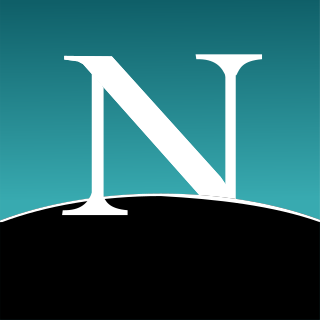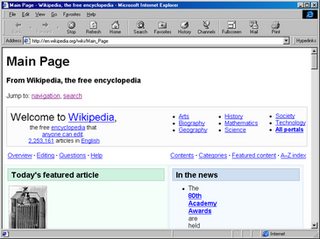
Internet Explorer is a series of graphical web browsers developed by Microsoft and included in the Microsoft Windows line of operating systems, starting in 1995. It was first released as part of the add-on package Plus! for Windows 95 that year. Later versions were available as free downloads, or in-service packs, and included in the original equipment manufacturer (OEM) service releases of Windows 95 and later versions of Windows. New feature development for the browser was discontinued in 2016 in favor of new browser Microsoft Edge. Since Internet Explorer is a Windows component and is included in long-term lifecycle versions of Windows such as Windows Server 2019, it will continue to receive security updates until at least 2029. Microsoft announced in August 2020 that as of August 2021, web-based Microsoft 365 products will no longer support Internet Explorer, while Microsoft Teams ended support for IE earlier in November 2020.

Netscape Navigator was a proprietary web browser, and the original browser of the Netscape line, from versions 1 to 4.08, and 9.x. It was the flagship product of the Netscape Communications Corp and was the dominant web browser in terms of usage share in the 1990s, but by around 2003 its use had almost disappeared. This was partly because the Netscape Corporation did not sustain Netscape Navigator's technical innovation in the late 1990s.
Shareware is a type of proprietary software which is initially provided free of charge to users, who are allowed and encouraged to make and share copies of the program. Shareware is often offered as a download from a website or on a compact disc included with a magazine. Shareware differs from freeware, which is software distributed at no cost to the user but without source code being made available; and open-source software, in which the source code is freely available for anyone to inspect and alter.

Cello is an early, discontinued graphical web browser for Windows 3.1; it was developed by Thomas R. Bruce of the Legal Information Institute at Cornell Law School. It was released as shareware in 1993. While other browsers ran on various Unix machines, Cello was the first web browser for Microsoft Windows, using the winsock system to access the Internet. In addition to the basic Windows, Cello worked on Windows NT 3.5 and with small modifications on OS/2.

Maxthon is a freeware web browser developed by the company Maxthon Ltd., based in Beijing, China. It is available for Windows, macOS, Linux, and as Maxthon Mobile for Android, iOS, and Windows Phone 8. As of version 3, Maxthon supports two web browser engines: WebKit and Trident.

The following tables compare general and technical information for a number of web browsers.
Go!Zilla is a proprietary download manager originally developed by Aaron Ostler in 1995, and later purchased by Radiate in 1999, for use on Windows. It is shareware and its previous ad supported version drew controversy among users and privacy advocates. Upon being acquired by Headlight Software in 2008, the ad-supported versions were discontinued and the software now offers a free limited trial.

IBM WebExplorer is an early, now discontinued, web browser designed at IBM facilities in the Research Triangle Park for OS/2.

Microsoft Internet Explorer 4 (IE4) is a graphical web browser that Microsoft released in October 1997, primarily for Microsoft Windows, but also with versions available for the classic Mac OS, Solaris, and HP-UX and marketed as "The Web the Way You Want It".

Microsoft Internet Explorer 3 (IE3) is a graphical web browser released on August 13, 1996 by Microsoft for Microsoft Windows and on January 8, 1997 for Apple Mac OS. It began serious competition against Netscape Navigator in the first Browser war. It was Microsoft's first browser release with a major internal development component. It was the first more widely used version of Internet Explorer, although it did not surpass Netscape or become the browser with the most market share. During its tenure, IE market share went from roughly 3–9% in early 1996 to 20–30% by the end of 1997. In September 1997 it was superseded by Microsoft Internet Explorer 4.

Microsoft Internet Explorer 2 (IE2) is the second major version of Internet Explorer (IE), a graphical web browser by Microsoft. It was released on November 22, 1995, for Windows 95 and Windows NT, and on April 23, 1996, for Apple Macintosh and Windows 3.1.
The Windows Metafile vulnerability—also called the Metafile Image Code Execution and abbreviated MICE—is a security vulnerability in the way some versions of the Microsoft Windows operating system handled images in the Windows Metafile format. It permits arbitrary code to be executed on affected computers without the permission of their users. It was discovered on December 27, 2005, and the first reports of affected computers were announced within 24 hours. Microsoft released a high-priority update to eliminate this vulnerability via Windows Update on January 5, 2006. Attacks using this vulnerability are known as WMF exploits.

Minnesota Internet Users Essential Tool (Minuet) is an integrated Internet package for DOS operating systems on IBM-compatible PCs.

Sandboxie is an open-source sandboxing program for Microsoft Windows. Sandboxie creates an isolated operating environment in which applications can be run or installed without permanently modifying the local system. This virtual environment allows for controlled testing of untrusted programs and web surfing. After various ownership transitions, Sophos eventually stated they would no longer be involved in the development of Sandboxie and that the open-source community would have to continue development instead.

Internet Explorer 9 or IE9 is the ninth version of the Internet Explorer web browser from Microsoft. It was released to the public on March 14, 2011. Microsoft released Internet Explorer 9 as a major out-of-band version that was not tied to the release schedule of any particular version of Windows, unlike previous versions. It is the first version since Internet Explorer 2 not to be bundled with a Windows operating system, although some OEMs have installed it with Windows 7 on their PCs, as well as new Windows 7 laptops.

Opera is a multi-platform web browser developed by Opera Software. Opera is a Chromium-based browser. It distinguishes itself from other browsers through its user interface, functionality, and other features.
Internet Explorer is a series of graphical web browsers developed by Microsoft and included as part of the Microsoft Windows line of operating systems, starting in 1995.

UdiWWW is an early, now discontinued freeware graphical HTML 3.2 web browser for 16-bit and 32-bit Microsoft Windows. It was written and developed by Bernd Richter in C/C++ from 1995 to 1996. Following the release of version 1.2 in April 1996, Richter ceased development, stating "let Microsoft with the ActiveX Development Kit do the rest."

FrameGang was an applet for developing HTML frames for Netscape released by Sausage Software in April 1996. The program featured a drag-and-drop interface that allowed users to define the number, size and position of the HTML frames without knowledge of HTML. It was one of the four "snaglets" along with Crosseye, Flash, and Clickette that were released by Sausage Software that month.

μTorrent, or uTorrent is a proprietary adware BitTorrent client owned and developed by BitTorrent, Inc. With over 150 million users it is the most widely used BitTorrent client outside China; globally only behind Xunlei. The "μ" in its name comes from the SI prefix "micro-", referring to the program's small memory footprint: the program was designed to use minimal computer resources while offering functionality comparable to larger BitTorrent clients such as Vuze or BitComet.










